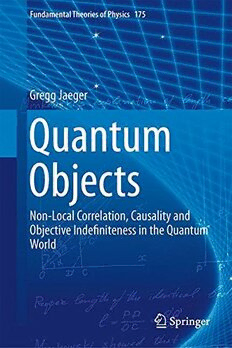Table Of ContentFundamental Theories of Physics 175
Gregg Jaeger
Quantum
Objects
Non-Local Correlation, Causality and
Objective Indefi niteness in the Quantum
World
Fundamental Theories of Physics
Volume 175
Series Editors
HenkvanBeijeren,UtrechtUniversity,Utrecht,TheNetherlands
PhilippeBlanchard,Universita¨tBielefeld,Bielefeld,Germany
PaulBusch,UniversityofYork,Heslington,York,UnitedKingdom
BobCoecke,OxfordUniversityComputingLaboratory,Oxford,UnitedKingdom
DetlefDu¨rr,MathematischesInstitut,Mu¨nchen,Germany
RomanFrigg,LondonSchoolofEconomicsandPoliticalScience,London,UnitedKingdom
ChristopherA.Fuchs,PerimeterInstituteforTheoreticalPhysics,Waterloo,Canada
GiancarloGhirardi,UniversityofTrieste,Trieste,Italy
DomenicoGiulini,UniversityofHannover,Hannover,Germany
GreggJaeger,BostonUniversityCGS,Boston,USA
ClausKiefer,UniversityofCologne,Cologne,Germany
KlaasLandsman,RadboudUniversiteitNijmegen,Nijmegen,TheNetherlands
ChristianMaes,K.U.Leuven,Leuven,Belgium
HermannNicolai,Max-Planck-Institutfu¨rGravitationsphysik,Golm,Germany
VesselinPetkov,ConcordiaUniversity,Montreal,Canada
AlwynvanderMerwe,UniversityofDenver,Denver,USA
RainerVerch,Universita¨tLeipzig,Leipzig,Germany
ReinhardWerner,LeibnizUniversity,Hannover,Germany
ChristianWu¨thrich,UniversityofCalifornia,SanDiego,LaJolla,USA
DennisDieks,UtrechtUniversity,Utrecht,TheNetherlands
Forfurthervolumes:
http://www.springer.com/series/6001
Gregg Jaeger
Quantum Objects
Non-Local Correlation, Causality
and Objective Indefiniteness
in the Quantum World
123
GreggJaeger
NaturalSciencesandMathematics
BostonUniversity
Boston
USA
ISBN978-3-642-37628-3 ISBN978-3-642-37629-0(eBook)
DOI10.1007/978-3-642-37629-0
SpringerHeidelbergNewYorkDordrechtLondon
LibraryofCongressControlNumber:2013947463
(cid:2)c Springer-VerlagBerlinHeidelberg2014
Thisworkissubjecttocopyright.AllrightsarereservedbythePublisher,whetherthewholeorpartof
thematerialisconcerned,specificallytherightsoftranslation,reprinting,reuseofillustrations,recitation,
broadcasting,reproductiononmicrofilmsorinanyotherphysicalway,andtransmissionorinformation
storageandretrieval,electronicadaptation,computersoftware,orbysimilarordissimilarmethodology
nowknownorhereafterdeveloped.Exemptedfromthislegalreservationarebriefexcerptsinconnection
with reviews or scholarly analysis or material supplied specifically for the purpose of being entered
and executed on a computer system, for exclusive use by the purchaser of the work. Duplication of
this publication or parts thereof is permitted only under the provisions of the Copyright Law of the
Publisher’slocation,initscurrentversion,andpermissionforusemustalwaysbeobtainedfromSpringer.
PermissionsforusemaybeobtainedthroughRightsLinkattheCopyrightClearanceCenter.Violations
areliabletoprosecutionundertherespectiveCopyrightLaw.
Theuseofgeneraldescriptivenames,registerednames,trademarks,servicemarks,etc.inthispublication
doesnotimply,evenintheabsenceofaspecificstatement,thatsuchnamesareexemptfromtherelevant
protectivelawsandregulationsandthereforefreeforgeneraluse.
While the advice and information in this book are believed to be true and accurate at the date of
publication,neithertheauthorsnortheeditorsnorthepublishercanacceptanylegalresponsibilityfor
anyerrorsoromissionsthatmaybemade.Thepublishermakesnowarranty,expressorimplied,with
respecttothematerialcontainedherein.
Printedonacid-freepaper
SpringerispartofSpringerScience+BusinessMedia(www.springer.com)
To myparents.
Preface
The conceptual elements of quantum theory that now underlie our picture of the
physical world include objective chance, quantum interference, and the objective
indefiniteness of dynamical quantities. Quantum interference, which is directly
observable,wasreadilyabsorbedbythephysicscommunity.Objectivechanceand
indefiniteness, being of more philosophical significance, gained acceptance only
after much debate and conceptualanalysis, when it was recognizedthat observed
phenomena are better understood through these notions than through older ones
or hidden variables. Of the results understood via these notions, the failure of
quantumsystemsalwaystoobeytheconstraintofBell’sinequalityanditstestable
successor,theCHSHinequality,hasbeenthemostdecisive.Theseinequalitiesare
now recognized as central results not only of quantum theory but of physics as a
whole. They concern the strength of correlations between properties of physical
systems that are expected given the finiteness of the speed of light and common
experience but are found not to encompass all of those found in the extended
rangeofexperiencerecentlyattainedbyscience,whichnowreachesfarbeyondthe
familiar.Thesenewobservationsbreachedtheconceptualcoreofphysicsinaway
thatdecadesofpreviousargumentstotheeffectthatQuantummechanicsgivesrise
toparadoxhadnot,becausenon-localpropertycorrelationswereshowntoconflict
withthedeepestclassicalmechanicalnotionsratherthanjustexplainingparticular
anomalies.The success of quantumtheorystronglyurgesus to acceptthe notions
mentioned above and others which require the modification of our conception of
whatagenericphysicalobjectisandhowitcanbe.
Earlier discussions and surprising results of quantum theory did not lead to
such a thoroughgoingquestioning of cherished notions regarding the content and
structure of the world, being typically limited to processes occurring at atomic
scales. Those previousresults conflicted primarilywith commonsense or showed
only the inadequacy of particular laws or rules rather than of our basic notions
regarding physical existence. It is for this reason that the question, for example,
of which position was victorious in the Bohr–Einstein debates over the viability
ofthethennewlyformulatedquantumtheorywasandisnotwidelyconsideredas
significant, for example, as that between the Ptolemaic and Copernican positions.
vii
viii Preface
However, the transition to the quantum world picture must be seen as at least as
significant as the transition to Copernican cosmology as grounded in Newtonian
mechanicsortotheacceptanceofbiologicalevolutionatthespecieslevel.
In the wake of the Bohr–Einstein debate, a more penetrating conservative
response to those physicists who were content with early quantum theory was
mounted by Einstein, Podolsky, and Rosen (EPR). The argument was relatively
more philosophical than previous ones and made explicit several conditions that
had arguably been implicit in the foundation of classical theory; it pointed out a
conflict between these conditions and behavior predicted by Quantum mechanics
for a pair of particles in a specific quantum state. The argument of EPR later
led John Bell more or less directly to his inequality, because it pointed directly
to an example of classically inexplicable behavior within an extended bipartite
physical system: The Bell inequality quantitatively demarcated a boundary of
classicallyexplicablebehaviorthatistrespassedinQuantummechanics,providing
a generalizable distinction between classical mechanical and extreme quantum
mechanical correlations. It also proved less obscure to many than both the EPR
argumentand the reasoningof Bohr by makingno use of terms such as reality or
phenomenon.
The EPR paper itself had already prompted Schro¨dinger to produce his own
touchstone articles on the predictions of quantum theory and its relationship to
space-time,whichalsoincludedhisfamouscatexampleandforthefirsttimeclearly
defined and named the characteristic feature associated with distinctly quantum
correlations:entanglement.EvenbeforetheEPRarticle,BohrandHeisenberghad
begun emphasizing the limitations inherent in the joint specification of physical
quantitiesinthequantumworldthatchallengedthosenaiveformsofmetaphysical
realismwhichcouldcomfortablybeheldtogetherwithclassicalphysics.Through
a series of incisive inquiries, beginning with this earlier work and leading to
experimentaltestingofthevalidityofBell-typeinequalities,itbecameentirelyclear
tophysiciststhatthenoveltiesofquantumtheoryinvolvemorethanthediscreteness
of basic physicalquantitiesand differencesin predictionson the merely technical
level,forexample,ofatomicspectraldistributions.
Attempts to produce a satisfying corresponding worldview began with their
appearance and have continued, with quanta being increasingly central to this
picture.Theinvestigationoftheunderlyingcharacteristicsofquantumsystems—the
pervasivenessofpropertyindefinitenessandextremelystrongpropertycorrelation
at non-local spatiotemporal separations—have also provided a context for the
emergence of quantum information science, to which some now look for a new
quantum perspective. The associated questions of the implications of quantum
mechanicsfortheconceptionofphysicalobjectsin space-timeandof theformof
causationappropriatetothequantumworldaretheprimarysubjectsofthisbook.
Lexington,USA GreggJaeger
2012
Acknowledgement
I thank Claus Ascheron at Springer–Heidelberg for encouraging me to write
this book as well as my research collaborators, particularly Paul Busch, Mauro
D’Ariano,SahotraSarkar,andAlexanderSergienko,fortheintellectualstimulation
relatingtovarioustopicsdiscussedhereandfortheirfriendship.
ix

